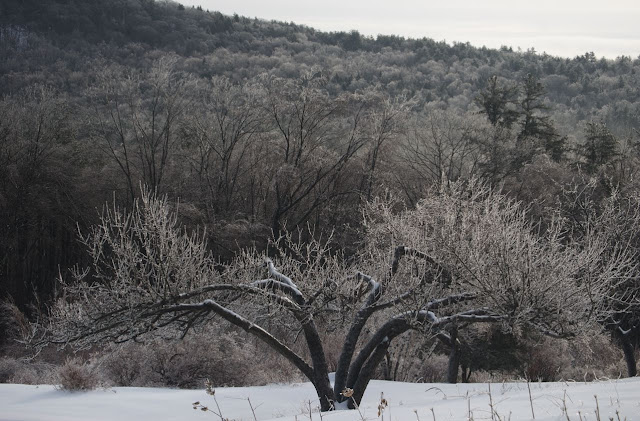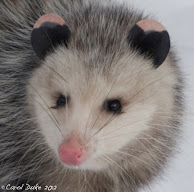One morning recently I looked out onto a glistening landscape. I had noticed the night before, as I walked to my barn studio, a peculiar twinkling within the branches of the shrubs and trees in front of the house.
I confess to not even knowing the name for this marvel. Two friends immediately said "Hoarfrost!", when I began describing what reminded me of tiny, thin crystals of dolomite or mica flakes of frost, covering countless branches and waiting buds or calyxes across the countryside.
There is a mysterious mystical quality about this phenomenon of water vapor freezing in still weather and collectively coating anything in its path, with a random design of frozen flakes. I was enchanted by the transparent jellyfish like bodies floating away in this photograph.
It has been very cold for humans and wildlife. I do worry for the Bluebirds! I was surprised to see six birds fly out of this house the other morning. One right after the other appearing at the hole and flying out. To see their little heads popping out one to six was a sight! I did not have my camera, but ran to get it and these not very good shots were all I could manage, looking out through two layers of windows. Three birds had already flown away. They must have been all huddled up together in the birdhouse to keep warm. I had read recently that someone found dead Bluebirds in a nest box similar to this one . . . that had clearly been trying to survive a freezing cold night in just this way. I do hope these birds are all safe. We are having a true winter for a change.
Snow keeps piling up. The large snow cake under the Crabapples has another solid layer and the chair snow cushions are thicker too.
The Crabapple Orchard is cozily covered in a bulky blanket of white and always a source of important winter bird food and entertainment for its steward!
Wild Turkeys look ever so large when teetering in the thin branches of Crabapples.
Looking through glass and a snowstorm they seem to be looking back trying to discern what my form is.
They use their wings to help maintain balance. Twinkletoes turkeys have been leaping into the Crabapples since they were planted nearly twenty years ago. It was very comical to see them in the early days, when the trees were tiny. Their weight might well have broken a branch or two.
Later that day, as the storm lifted, several Wild Turkeys came back to the Crabapples. I was able to sneak the door open a bit to get better shots. This time they are atop a tree further away within what I call 'The Three Graces' . . . a cluster of three trees not inside the orchard.
I read in National Geographic that Benjamin Franklin had wanted the native Wild Turkey to be our National bird. As this turkey walks into the Crabapple Orchard, she does have a rather patrician look about her.
For every bird that is in the trees there are more below gathering the fallen apples. Not one tiny apple is wasted. The sun reflects beautiful colors in their luxuriant coat of feathers.
Females will feed their young for only a few days and then the little ones follow their mothers and feed themselves within the larger flock of hens and chicks. I have often seen large flocks of over forty birds including the chicks crossing the road or down in the blueberry field eating blueberries. They love the crabapples but also eat acorns from the many oaks here, seeds, insects (including ticks!!), buds and even salamanders. I see them foraging for seeds in the open fields. They will jump up and down to reach seeds on taller plants. Chicks are so adorable when crossing the road . . . though I fear for them . . . as they usually walk in a straight line one behind the other much like ducklings. Within the gardens, fields and forest I see the turkeys trekking along moving in one direction behind a leader. Throughout the seasons it is a joy to hear the gobbling calls and songs of the males which are carried up from the forest.
It is hard to imagine that these noble birds were nearly extinct in the early 20th century. They had all but disappeared from the northeast, from over hunting and loss of habitat. Humans did regain their sanity in time to save the Wild Turkey and reintroduced them successfully to their former ranges and even places they had not lived before. Wild Turkeys have a fear of humans for good reasons, so that whenever I try to open a window or door to capture them better they take flight in great fright! I keep hoping that they will get used to me but it does not seem to happen. I do not think they have very good eyesight. When flying and right before landing they offer a spectacular display. I want to join Gail's Wildflower Wednesday a day late and not really flowers at all, but surely as wondrous as any flora.


















































































































































